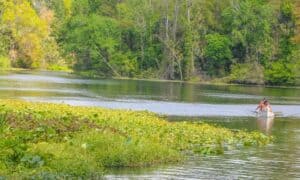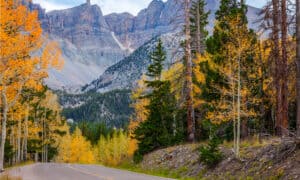West Virginia, touted as the Mountain State is a scenic treasure trove. Located in the eastern United States, West Virginia lives up to its slogans’ Wild and Wonderful’ and ‘Almost Heaven.’ The state is full of natural beauty from mountain peaks and cavernous valleys. This wonderful state offers a vast range of outdoor activities, such as skiing, rafting, and backpacking, to name a few.
West Virginia is the only state located entirely within the Appalachian Mountains. The state, known for its rolling hills and mountains, has historically been associated with its role during the Civil War and its coal mining industry. The region is also home to ancient manufactured mounds of earth dating back to the Iroquois tribes. These mounds, amidst many other natural wonders in West Virginia, attract visitors annually.
The History of West Virginia’s Landscape
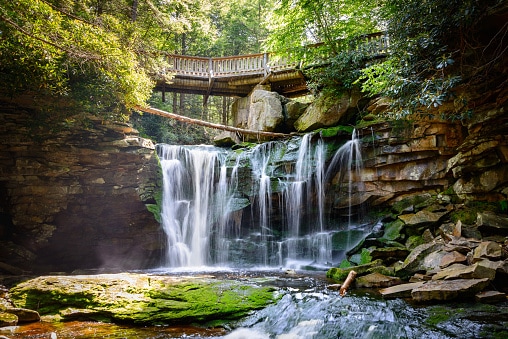
The landscape of West Virginia is mountainous and rocky, as evidenced by Blackwater Falls in Davis, WV.
©zrfphoto/iStock via Getty Images
In 2010, a study from Ohio University discovered stalagmites that pointed to Native American activity dating back to 100 BCE. This study found evidence from Native Americans that suggested their lifestyles and habits might have contributed to the region’s landscape. This study is one example of West Virginia’s rich history and interesting topography. When it comes to the state’s interesting topography, there is an abundance of caves to explore.
The Best Caves in West Virginia
Whether it’s a craggy mountainside thousands of feet upwards or a hidden cavern buried beneath the earth, West Virginia is overflowing with exciting places to explore. If you’re feeling like an adventurous trek through some incredible caves and caverns, check out this list of the top six best caves in West Virginia.
1. Lost World Caverns

These are some stalagmite and stalactite formations at Lost World Caverns near Lewisburg.
©Leepaxton at English Wikipedia, CC BY-SA 4.0 , via Wikimedia Commons – Original / License
Located in Lewisburg, West Virginia, Lost World Caverns invites you to descend 120 feet below the Earth’s surface. In 1942, Lost World Caverns was discovered by Virginia Polytechnic Institute and State University. Nearly thirty years later, in 1973, the caverns were registered as a National Natural Landmark. The cave is home to one of the potentially largest stalactite formations in the nation. The formation, known as The Snowy Chandelier, weighs 30 tons. Other popular formations include The Bridal Veil, a sparkling white calcite column, and the War Club, a 28-foot stalagmite.
Lost World Cavern is 235 feet deep and 1.25 miles long, and the stalagmites in the cave reach nearly 80 feet tall. The cave is open for self-guided tours, which lasts approximately 45 minutes and covers a ½ mile loop. If you’re feeling a bit more adventurous, a “Wild Cave Tour” extends beyond the standard walking tour loop. This tour takes participants into the cavern’s deeper, more undeveloped parts.
The caverns’ temperatures run about 52 degrees Fahrenheit, so wear a light jacket when you visit. And don’t forget to wear sturdy shoes!
Lost World Caverns Fun Fact
In 1967, the remains of a prehistoric cave bear were found in the cave. In 2015, another discovery was made: the remains of the oldest black bears in West Virginia.
2. Smoke Hole Caverns

You can see an above shot of Smoke Hole Cavern’s interior.
©Gregory & Sarah, CC BY-SA 3.0 , via Wikimedia Commons – Original / License
Located in Cabins, WV, Smoke Hole Caverns got its name from smoke, which might be evident that Smoke Hole Caverns is tied to the history of the Seneca Indians. They used the front of the cave to smoke wild game. The wood fires sent out swirling smoke, a familiar spectacle across the valley, which eventually warranted settlers calling the place Smoke Hole.
Smoke Hole Caverns isn’t only known for smoke; it’s also connected to moonshine. The spacious, secluded nature of the caverns made it easy for Prohibition-era settlers to make moonshine from the cavern’s inner streams. It’s thought that as many as 20 stills were operating at one time.
History and lore aside, Smoke Hole Caverns opened publicly in 1940. This was three years after the Monongahela National Forest included the caverns. The cavern is home to the Room of a Million Stalactites, the main room of the cavern, which has a 274-foot ceiling.
If you’re interested in visiting, the tours at Smoke Hole Caverns are all guided. These tours typically last 45 minutes to one hour, and the tour itself is approximately 2/3 of a mile. Temperatures are consistently 56 degrees F, but the cave is pretty humid.
Smoke Hole Caverns Fun Fact
There are claims that the cave has the world’s longest ribbon stalactite. A stalactite is a type of rock formation which has layers of flowstones.
3. Seneca Caverns

This is part of Seneca Caverns; you can see how it slopes downward into a separate area.
©http://www.ForestWander.com, CC BY-SA 3.0 US , via Wikimedia Commons – Original / License
Like other caves located in West Virginia, Seneca Caverns has a rich history. There is evidence of the cave forming nearly 460 million years ago, but the first verifiable human use dates back to the early 1400s. At that time, the area was a Seneca Indian settlement. Seneca Caverns is located on what used to be an Indian trading route in Pendleton County within the Appalachian Mountains. Although many Indians used this trading route, it was the Seneca Indians who lived in the area and used the cave for shelter.
Over three hundred years later, German settlers inhabited the area, and Laven Teter rediscovered the cave in 1742. The cave remained in the Teter family until 1928. At that point, the cave was bought by new owners. The new owners opened Seneca Cavers to the public in 1930.
The underground tour of Seneca Caverns runs approximately 45 minutes with 1 mile of trail. Upon entering the cave, you will descend 165 feet below ground. The trail is well-lit and does have handrails for enhanced safety. If you are a thrill-seeker, you can partake in The Stratosphere Cavern tour. This particular tour requires you to be at least 12 years of age. There is no lightning, except for the small lights provided, and climbing is required in certain parts of this more advanced tour.
Seneca Caverns Fun Fact
Near Seneca Caverns, you can find “Seneca Rocks.” Legend has it that Princess Snow Bird, the sole daughter of Chief Bald Eagle, found her true love at the top. When expected to choose a worthy suitor, the princess issued a challenge: any man who could make it to the top of the rocks could marry her. Seven set out on the harrowing journey, but only one survived and reached the top. This man supposedly became the successor to Chief Bald Eagle.
4. Cass Cave

“The Big Room” is an 800-foot long, 180-foot-high, and 75-foot-wide room in the cave.
©https://commons.wikimedia.org/wiki/File:Big_Room.jpg – Original / License
Located conveniently in Cass, WV, Cass Cave is at Cheat Mountain’s top. Cass Cave is home to West Virginia and Virginia’s highest subterranean, or underground waterfall. Lady Suicide Falls is 140 feet tall and possibly taller than any aboveground or underground waterfall in West Virginia.
Inside Cass Cave, you will not only find Lady Suicide Falls but also “The Big Room,” an 800-foot-long, 180-foot-high, and 75-foot-wide room. Cass Cave also includes 2.3 miles of mapped passage. However, spelunkers, beware: this cave is difficult to explore because of the waterfall. To reach The Big Room, you must descend 175 feet downward. The descent is especially scary because the rushing waterfall is close to the downward trail.
This cave is not open to the general public, and only experienced, well-equipped individuals should attempt the trek into Cass Cave.
Cass Cave Fun Fact
In 1964, National Geographic featured in Cass Cave. The issue featured a two-page spread of a caver climbing a wire ladder adjacent to the waterfall.
5. Organ Cave
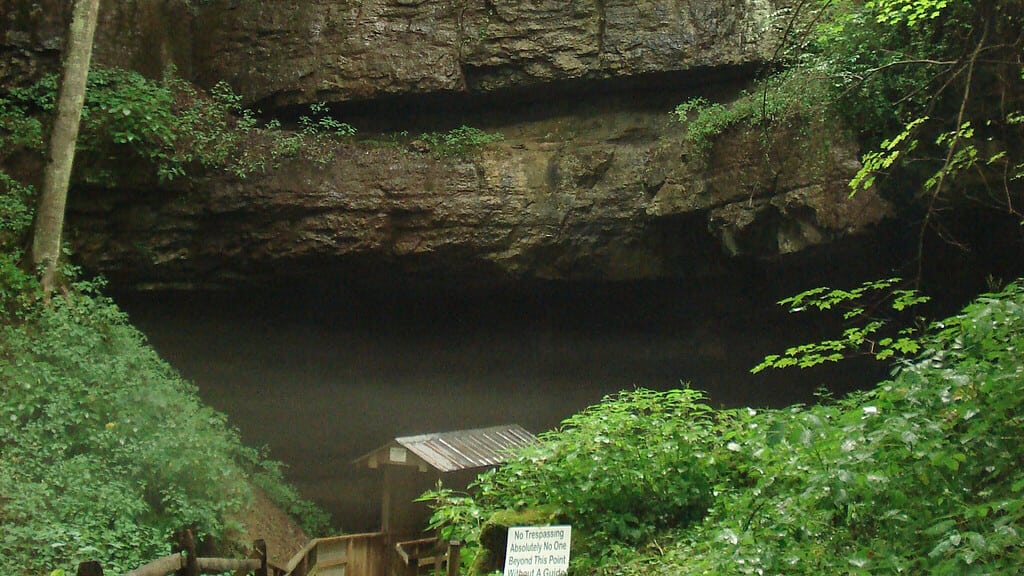
This is the exterior entrance to Organ Cave.
©Valerius Tygart, CC BY-SA 3.0 , via Wikimedia Commons – Original / License
Organ Cave is one of the most complex cave systems in the eastern United States. The Organ Cave System contains seven caves, including the Organ Cave. The cave has over 45 miles of mapped passages and over 200 leads that could potentially be mapped and surveyed. During the Revolutionary War, the cave was mined for saltpeter, the main ingredient in gunpowder. Nearly a hundred years later, Confederate General Robert E. Lee would hold a church service in the main entrance of the cave during the Civil War.
Of course, Organ Cave is known for its historical facets, but it is also home to incredible rock formations and prehistoric fossils. This cave is the site of the first prehistoric three-toed sloth discovered in the late 1800s. Locally dubbed “The City of the Underworld,” a West Virginia historian claims that Thomas Jefferson visited the cave before the area was settled.
Organ Cave Fun Fact
The cave famously received its name after a calcite drapery that resembles a pipe organ.
6. Sinks of Gandy
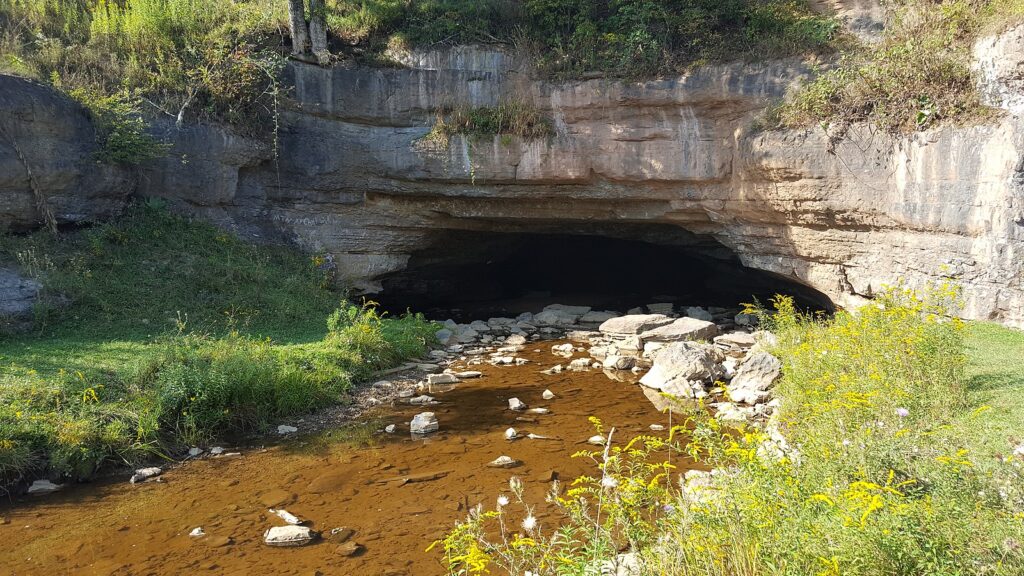
This is the creek-side entrance of Sinks of Sandy. There is a dry entrance in a different location.
©Kyle Toby, CC BY-SA 4.0 , via Wikimedia Commons – Original / License
Sinks of Gandy isn’t your ordinary cave, but it might also be the most popularized “cave” in West Virginia history. While Sinks of Gandy touches Native American and Civil War history, the cave also gained notoriety when an author published a tongue-in-cheek account about the region in Harper’s Magazine. Writer Jack Preble later redeemed Sinks of Grandy by providing a more accurate account of the cave, which perfectly aligned with the development of the West Virginia Highway Department and the state’s interest in tourism.
Nicknamed “The Sinks,” Sinks of Gandy is part cave and underground stream within the Monongahela National Forest. Both entrances to The Sinks are located on private land, and it takes a little exploration to find the caves’ entrances. Once you identify the right direction, follow Gandy Creek until it disappears underground into Gandy Cave. The river tunnels through the Sinks of Gandy, and visitors can trek through the cave to the other side, where the creek once again flows freely. The Grandy Creek flows through the cave tunnel for about 3,000 before disappearing into the ground and eventually flowing into the Dry Fork River.
The watery cave trail takes approximately an hour to complete. It is a cold, slippery trek, so sturdy shoes and thermal clothing are recommended.
Sinks of Gandy Fun Fact
The Sinks are located on private property, so the exact location must be kept secret. Spelunkers are welcome to explore, but the property owners aren’t keen on publishing the location.
Explore Wild and Wonderful West Virginia
This list is only a sampling of West Virginia’s 4,241 reported caves. While many of these caves are small, 1,810 are about 33 feet deep. There are only 106 caves that have more than one mile of surveyed passages. Greenbrier, Pocahontas, Pendleton, Randolph, and Monroe counties have the highest reported caves, accounting for nearly three-quarters of West Virginia caves and totaling 2,977 caves.
West Virgina’s caves offer an unparalleled experience to explore a geological splendor beneath the state’s rolling hills and forest-covered landscape. Whether you’re interested in a well-guided tour experience at Lost World Caverns or discovering the hidden wonders as a spelunker at Organ Caves, the state is a haven for adventurous nature enthusiasts.
There are options for the experienced caver and novice explorer, and these top six caves will undoubtedly scratch the adventure itch. Grab your cave-exploring gear, flashlight, and sturdy waterproof shoes, and prepare to trek through an unforgettable underground journey.
The photo featured at the top of this post is © LAByrne/iStock via Getty Images
Thank you for reading! Have some feedback for us? Contact the AZ Animals editorial team.





